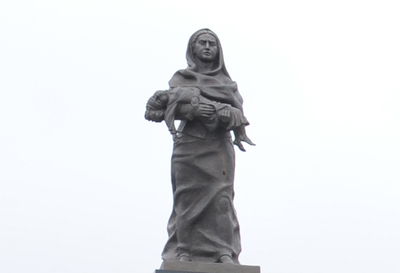
Today, Azerbaijan held an annual campaign to mark the 22nd anniversary of Khojaly massacre, the killing of 613 civilians in the Azerbaijani-populated town of Khojaly in Nagorno-Karabakh on February 26, 1992.
It is considered a highly sensitive occasion in Azerbaijan and for its leadership. Each year the president of the country issues executive decrees for holding commemorative events in Azerbaijan’s major cities and districts, and personally attends the memorial built for the victims of Khojaly in central Baku. The memorial monument is of an exhausted woman with what seems a diseased child in her arms, reflecting the escape of the female to safety with a killed infant; or a mother Azerbaijan holding in her arms the lost child – Khojaly. However you choose to interpret, the message is still emotional for Azeris.
Khojaly was a relatively big town of 2,000 people (previously 8,000, most of which escaped before the massacre took place) in the central part of Nagorno-Karabakh which was surrounded by Armenian-held villages. By the beginning of February all communications with the town all but ceased. The remaining population, staying in the town by choice or by necessity, had to rely on commodities that were available since previous fall. Armenians were determined to take the city by force. If they waited a little, the town would have probably died in blockade of starvation, or surrendered for that matter.
However, as it turned out, the assault on Khojaly was not just intended to end with a capture of a territory from an enemy, but was aimed to cause psychological damage. At the very least, this is what the Azeris contend it was. Armenians, on the other hand, maintain that the capture was a strategic and immediate goal because Azeris kept showering Armenian-populated Stepanakert (Azeris call it Khan Kendi) with Grad missiles from Khojaly. What had happened upon the capture of the town though makes one believe in the former version of events. A town with a few months of siege and starving population is hardly going to assault the enemy on its own. Instead, it will make use of its heavy weaponry to defend itself, provided it does have those weapons.
What’s more, the town was captured with extreme show of violence. Many civilians were killed upon the capture of the town, many hundreds more were massacred in the flight to safety. Armenian military personnel deliberately massacred the Azeri civilians and reportedly mutilated their body parts. The scene of the massacre was filmed by the international journalists once the Armenians left the site.
The massacre certainly raised concerns in the international community which condemned the killings but stopped short of acting to bring justice to the victims. The Azeri side claims, and the Human Rights Watch reaffirms the claim, that the 366th motorized regiment of Soviet armed forces deployed in the Armenian-populated Stepanakert assisted the Armenian army with the mission and left the town as soon as it was conquered. The 366th regiment would then be disbanded in the neighboring state of Georgia to the north in March of that year.
Armenian government and the Armenian authorities in what is now the unrecognized state on Azerbaijani territories, deny the killings and claim that the Azeri Popular Front deliberately planned the execution of its own civilians in Khojaly in order to cause public outrage and remove the then president of Azerbaijan Ayaz Mutalibov. Mutalibov was indeed removed from power by his own choice. A few days after the massacre, the president resigned himself under continuous pressure from the opposition and the people. The opposition claimed that the people of Khojaly had asked the government to break the siege and restore vital communication with Azerbaijani towns – a demand the government of Mutalibov failed to meet. Yet, there is no evidence to substantiate the claim that Azeri Popular Front did anything to harm their own kind.
Since Khojaly massacre took place, the tragedy had a profound effect on the psyche of Azeri people which became palpable over a short period of time. Most of the civilians in the conflict zone started fleeing the Azeri-populated towns and villages at a mere sight of Armenian offensives. This secured quick and relatively bloodless victories for Armenians who took over quite a few more towns and villages from the Azeris in the coming months.
Khojaly, as well as Nagorno-Karabakh in its entirety, has been under Armenian control since May, 1994 when the ceasefire agreement was signed. More that 800 thousand Azeris had become refugees as a result. The region is recognized as a de-jure part of Azerbaijan. Armenians have lobbied for recognition of their state on international level but their efforts have gone in vain so far. Russia, a strong supporter of Armenia, plays both sides by awarding Armenia an ally status and defending its borders and by engaging Azerbaijan on a more diplomatic level. The region continues to be militarized and shootouts along the frontline are frequent. The conflict resolution is sought by both parties through the OSCE Minsk Group, represented by the United States, France and Russia as its primary co-chairs. Neither side has agreed to the peace deals in their entire forms.




